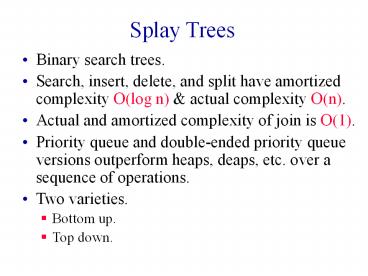Splay Trees PowerPoint PPT Presentation
Title: Splay Trees
1
Splay Trees
- Binary search trees.
- Search, insert, delete, and split have amortized
complexity O(log n) actual complexity O(n). - Actual and amortized complexity of join is O(1).
- Priority queue and double-ended priority queue
versions outperform heaps, deaps, etc. over a
sequence of operations. - Two varieties.
- Bottom up.
- Top down.
2
Bottom-Up Splay Trees
- Search, insert, delete, and join are done as in
an unbalanced binary search tree. - Search, insert, and delete are followed by a
splay operation that begins at a splay node. - When the splay operation completes, the splay
node has become the tree root. - Join requires no splay (or, a null splay is
done). - For the split operation, the splay is done in the
middle (rather than end) of the operation.
3
Splay Node search(k)
- If there is a pair whose key is k, the node
containing this pair is the splay node. - Otherwise, the parent of the external node where
the search terminates is the splay node.
4
Splay Node insert(newPair)
- If there is already a pair whose key is
newPair.key, the node containing this pair is the
splay node. - Otherwise, the newly inserted node is the splay
node.
5
Splay Node delete(k)
- If there is a pair whose key is k, the parent of
the node that is physically deleted from the tree
is the splay node. - Otherwise, the parent of the external node where
the search terminates is the splay node.
6
Splay Node split(k)
- Use the unbalanced binary search tree insert
algorithm to insert a new pair whose key is k. - The splay node is as for the splay tree insert
algorithm. - Following the splay, the left subtree of the root
is S, and the right subtree is B.
- m is set to null if it is the newly inserted
pair.
7
Splay
- Let q be the splay node.
- q is moved up the tree using a series of splay
steps. - In a splay step, the node q moves up the tree by
0, 1, or 2 levels. - Every splay step, except possibly the last one,
moves q two levels up.
8
Splay Step
- If q null or q is the root, do nothing (splay
is over). - If q is at level 2, do a one-level move and
terminate the splay operation.
- q right child of p is symmetric.
9
Splay Step
- If q is at a level gt 2, do a two-level move and
continue the splay operation.
- q right child of right child of gp is symmetric.
10
2-Level Move (case 2)
- q left child of right child of gp is symmetric.
11
Per Operation Actual Complexity
- Start with an empty splay tree and insert pairs
with keys 1, 2, 3, , in this order.
12
Per Operation Actual Complexity
- Start with an empty splay tree and insert pairs
with keys 1, 2, 3, , in this order.
13
Per Operation Actual Complexity
- Worst-case height n.
- Actual complexity of search, insert, delete, and
split is O(n).
14
Top-Down Splay Trees
- On the way down the tree, split the tree into the
binary search trees S (small elements) and B (big
elements). - Similar to split operation in an unbalanced
binary search tree. - However, a rotation is done whenever an LL or RR
move is made. - Move down 2 levels at a time, except (possibly)
in the end when a one level move is made. - When the splay node is reached, S, B, and the
subtree rooted at the splay node are combined
into a single binary search tree.
15
Split A Binary Search Tree
16
Split A Binary Search Tree
B
A
b
C
a
D
c
d
E
e
m
f
g
17
Split A Binary Search Tree
A
B
C
b
a
D
c
d
E
e
m
f
g
18
Split A Binary Search Tree
A
B
b
a
C
D
c
d
E
e
m
f
g
19
Split A Binary Search Tree
A
B
b
a
C
c
D
E
d
e
m
f
g
20
Split A Binary Search Tree
A
B
E
b
a
C
e
c
D
d
m
f
g
21
Split A Binary Search Tree
A
B
E
b
a
C
e
g
c
D
f
d
m
22
Two-Level Moves
- Let m be the splay node.
- RL move from A to C.
- RR move from C to E.
- L move from E to m.
23
RL Move
24
RL Move
A
B
b
a
Same outcome as in split.
25
RR Move
A
B
b
a
26
RR Move
A
B
b
a
D
C
d
c
E
e
m
Rotation performed.
f
g
Outcome is different from split.
27
L Move
A
B
b
a
D
C
d
c
E
e
m
f
g
28
L Move
A
B
E
b
a
D
e
C
d
c
m
f
g
29
Wrap Up
m
f
g
A
B
E
b
a
D
e
C
d
c
30
Wrap Up
m
A
B
E
b
a
D
g
e
C
f
d
c
31
Wrap Up
m
A
B
E
b
a
D
g
e
C
f
d
c
32
Bottom Up vs Top Down
- Top down splay trees are faster than bottom up
splay trees.

